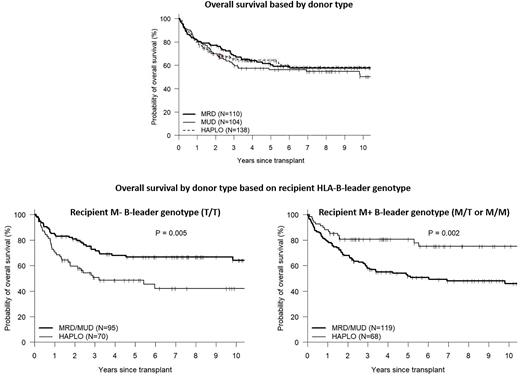Abstract
Choosing the best donor type for allogeneic transplant (HLA-matched related (MRD) or unrelated (MUD) vs. haploidentical (HAPLO)) is typically based on the timely availability of an HLA-matched donor. There is currently no role for either patient or disease characteristics to facilitate this decision. In the context of HAPLO transplant, our group has previously demonstrated that an M+ recipient HLA-B-leader genotype (either M/T or M/M) is associated with reduced relapse risk and superior survival in patients with lymphoid, but not myeloid, malignancies (Solomon et al. TCT journal 2022). Based on this finding, we hypothesized that recipient HLA-B-leader genotype may be important in donor selection. To this end, we analyzed 352 patients with lymphoid malignancies (ALL[ 166], NHL [111], HL [39] and CLL [36]) receiving a first allogeneic transplant from an MRD [110], MUD [104] or HAPLO [138] donor. GVHD prophylaxis was PTCy-based in all HAPLO recipients, in contrast to MRD and MUD recipients who received conventional prophylaxis with calcineurin inhibitor + methotrexate. M+ or M- (T/T) genotype was seen in 165 (47%) and 187 (53%) respectively. Compared to MUD and MRD, HAPLO recipients tended to be younger (median 46 vs. 49 and 51 years respectively) and less likely to be non-Hispanic white (46% vs. 90% and 71% respectively). There were no differences in baseline characteristics between patients with M+ and M- B-leader genotype. Overall, MRD, MUD and HAPLO recipients had similar overall survival (OS, see figure). In HAPLO recipients, those with an M+ HLA-B-leader demonstrated improved 5-yr OS and DFS when compared to M- recipients (81% vs. 49%, p<0.001 and 70% vs. 42%, p=0.001, respectively), due to decreased relapse risk (18% vs. 48%, p=0.002). In multivariable analysis (MVA), controlling for other relevant variables (e.g. age, race, DRI, conditioning intensity, transplant year), M+ HAPLO transplant recipients had decreased relapsed risk (HR 0.27, p<0.001) leading to improved DFS (HR 0.34, p<0.001) and OS (HR 0.28, p<0.001). In contrast, relapse and DFS did not significantly differ according to recipient HLA-B-leader genotype in MRD or MUD recipients in either univariate or MVA. We then analyzed differences in transplant outcome according to donor type (HAPLO vs. MRD/MUD) and recipient HLA-B-leader genotype (M+ vs. M-). In univariate analysis, M+ HAPLO recipients had superior 5-yr OS and DFS when compared to M+ MRD/MUD recipients (81% vs. 52%, p=0.002 and 70% vs. 47%, p=0.008, respectively). In contrast, M- HAPLO recipients demonstrated inferior 5-yr OS and DFS when compared to M- MRD/MUD recipients (49% vs. 67%, p=0.005 and 42% vs. 57%, p=0.022, respectively) (see figure). This result was confirmed in MVA where M- HAPLO recipients demonstrated inferior OS and DFS compared to M- MRD/MUD recipients (HR 2.83, p<0.001 and HR 2.06, p=0.003 respectively). Conversely, M+ HAPLO recipients showed superior OS and DFS (HR 0.54, p=0.045 and HR 0.57, p=0.036 respectively). In summary, recipient HLA-B-leader genotype predicts relapse risk and survival following PTCy-based HAPLO transplant for lymphoid malignancy, but not MRD/MUD transplant utilizing conventional GVHD prophylaxis. As a result, recipient HLA-B-leader genotype can help guide optimal donor selection for patients with lymphoid malignancies with preference for MRD/MUD or HAPLO donor in the context of recipient M- or M+ HLA-B-leader genotype, respectively.
Disclosures
Solh:ADC Therapeutics: Research Funding; Partner Therapeutics: Research Funding.
Author notes
Asterisk with author names denotes non-ASH members.


This feature is available to Subscribers Only
Sign In or Create an Account Close Modal